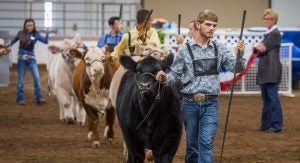Summer nights under barn lights. Fall on the football field. There’s not much that evokes American nostalgia quite like high school sports and, for those of us in the agriculture industry, FFA. However, time and finances are finite resources, and when it comes to FFA and sports, sometimes, it can mean making a choice.
For members, parents, FFA advisors, and 4-H agents, balancing things like 4-H commitments, sports practices, livestock shows, and leadership opportunities for our kids is a never-ending battle.
As a former 4-H agent, when an officer would miss a meeting due to a sporting practice or event or a member would bow out of showing livestock in a given year to focus on sports, the consensus seemed to be that when it came down to 4-H versus sports, sports were always going to win.
But, can our kids have both? We asked, and the answers were varied
There’s no question in the minds of those of us who’ve seen the benefits of the National FFA Organization on our youth just how big of a lifelong impact FFA (or 4-H) activities can have on our youth.
But, so can sports.
We often hear that fewer than 2 percent of high school student-athletes are offered athletic scholarships to college. However, those scholarships add up to over $2.7 billion annually for Division I and Division II sports alone.
The National FFA Scholarship Program offers more than 120 scholarships each year, and there are more than $2.7 million in funds available. That’s just at the national level.
Texas, which has the largest number of FFA members with 169,333, awards more than $1 million in scholarships annually to members.
It’s true, that few organized high school activities can offer so much by financial volume to our students. Despite this, there are over 850,823 FFA members in 8,995 chapters in 50 states.
One AGDAILY reader commented, “Easy. One will teach you skills you can use for life. The other will likely leave you scarred for life.”
And, it’s true. Overall, the FFA provides students with a physical and emotional sense of belonging. Members build self-confidence, self-esteem, and learn social skills. According to the National FFA Organization, collectively, FFA members earn more than $4 billion annually through their hands-on work experiences.
Meanwhile, among high school athletes, more than 5.2 million injuries occurred between 2015 and 2019, according to the American Academy of Orthopedic Surgeons.
Another reader commented, “Anything is possible, but at what price, and will it be used wisely in the future?”

For each family, the answer is going to be different:
- “Hell, if I know — bank accounts empty, the gas tanks empty, and I have no idea how everything gets done around here… but in 5 years, it’s gonna be awfully quiet around here,” said Keon Holzer.
- “We don’t. We told our kids that they had to pick. You can’t be good at anything if you spread yourself too thin. Our crew chose to pursue their 4-H projects and interests. Sports are fun, but at the end of the day, I feel they’re learning a lot more useful things in their other activities. Our competitive family has found plenty of ways to challenge ourselves and compete outside of the sports scene,” Austin and Amber Kennon commented.
- “It’s really tough. Almost impossible. Any projects have to be done in the winter,” wrote The Diversified Farmer.
- “My oldest was a three-sport athlete, captain of the football and baseball teams, along with studying for National FFA Forestry and Wildlife competitions (sophomore and senior years, respectively). He had to manage his time wisely and study extremely hard to make things work. He stayed up late studying and utilized his ag class time very wisely to make studying for State and Nationals. Anything is possible with a strong will and desire to compete on and off the field. He’s now a junior in college also playing baseball and maintaining the Dean’s List,” wrote Barb Linder.

Find out what the kids want to do, and how we can support them from there
For members and athletes, it comes down to effective communication and a willingness by coaches and advisors to listen to students.
“There’s no one set answer, but I think it’s a three-part solution. Support and communication have to start at the member-parent level. And then advisors and coaches have to be able to work together. In an ideal situation, you have a supportive administration that wants to see students succeed in as much as they can while they’re students,” said one New Mexico FFA advisor.
It also comes down to supporting kids, and school administration can play a part too.
“Every kid needs to have a coach who wants them to succeed, but what does the kid want to do? It needs to be at least one thing, and it’s not always going to be sports. These activities allow someone to check on our students, be involved with them, and to check on them. My role is to make sure that everyone has that one thing and to provide equal access and support to those programs. But, kids need to have choices, and it’s up to educators as adults to support them, not punish them,” said one high school administrator.
It’s not a simple solution, and when coaches don’t see the value in FFA membership, it gets a bit more complicated.
“It is so hard to have active FFA members with all high school sports ‘training’ for 12 months. It is almost impossible to practice CDE’s after school because of sports practices,” said one South Carolina advisor.
“As an FFA advisor and CDE coach, I get so tired of fighting with athletics over precious time. Sports are king,” said one Nevada FFA advisor.
Hats off to the advisors who make it work and advocate for FFA’s role in students’ lives and futures.
Some advisors commented that they make CDE practices work by teaching and coaching during classroom time. It’s time-consuming and not always effective, but it’s one-way students can fit in FFA and sports practices.
Other advisors hold practices before school. One of our local 4-H clubs holds 7 p.m. meetings on Thursdays when game travel isn’t likely.
One thing is for sure: Students and parents who want to do both FFA and sports … prepare to be tired. And ultimately, whether they choose one or the other, there will be times when students have to make choices, and that’s OK too.
»Related: Perspective: It’s important to understand that market livestock’s ‘end game’ is the dinner table
Heidi Crnkovic, is the Associate Editor for AGDAILY. She is a New Mexico native with deep-seated roots in the Southwest and a passion for all things agriculture.



